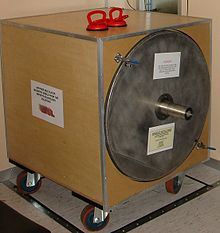- Mu-metal
-
Mu-metal is a nickel-iron alloy (approximately 77% nickel, 16% iron, 5% copper and 2% chromium or molybdenum).[1] that is notable for its high magnetic permeability. The high permeability makes mu-metal very effective at screening static or low-frequency magnetic fields, which cannot be attenuated by other methods. The name came from the Greek letter mu (μ) which represents permeability. A number of different proprietary formulations of the alloy are sold under trade names such as Mumetal, MuMetal, and MuShield; this article will cover their common features.
Mu-metal typically has relative permeability values of 80,000–100,000 compared to several thousand for ordinary steel. In addition it has low magnetic anisotropy and magnetostriction,.[1] giving it a low coercivity that results in low hysteresis losses in AC magnetic circuits. Other high permeability alloys such as permalloy have similar magnetic properties; mu-metal's advantage is that it is more ductile and workable, allowing it to be easily formed into the thin sheets needed for magnetic shields.[1]
Mu-metal objects require heat treatment after they are in final form — annealing in a magnetic field in hydrogen atmosphere, which reportedly[by whom?] increases the magnetic permeability about 40 times. The annealing alters the material's crystal structure, aligning the grains and removing some impurities, especially carbon, which obstruct the free motion of the magnetic domain boundaries. Bending or mechanical shock after annealing may disrupt the material's grain alignment, leading to a drop in the permeability of the affected areas, which can be restored by repeating the hydrogen annealing step.
Contents
Magnetic shielding
The high permeability of mu-metal provides a low reluctance path for magnetic flux, leading to its major use, in magnetic shields against static or slowly varying magnetic fields. Magnetic shielding made with high permeability alloys like mu-metal works not by blocking magnetic fields but by providing a path for the magnetic field lines around the shielded area. So the best shape for shields is a closed container surrounding the shielded space. The effectiveness of mu-metal shielding decreases with the alloy's permeability, which drops off at both low field strengths and, due to saturation, at high field strengths. So mu-metal shields are often made of several enclosures one inside the other, each of which successively reduces the field inside it. RF magnetic fields above about 100 kHz can be shielded by Faraday shields, ordinary conductive metal sheets or screens which are used to shield against electric fields.[2]
History
Mu-metal was developed by scientists named Smith and Garnett and patented in 1923 for inductive loading of submarine telegraph cables by The Telegraph Construction and Maintenance Co. Ltd. (now Telcon Metals Ltd.), a British firm which built the Atlantic undersea telegraph cables.[3][4] The conductive seawater surrounding an undersea cable added a great deal of capacitance to the cable, causing distortion of the signal, which limited the bandwidth and slowed signaling speed to 10–12 words per minute. The bandwidth could be increased by adding inductance to compensate. This was first done by wrapping the conductors with a helical wrapping of metal tape or wire of high magnetic permeability, which confined the magnetic field. Mu-metal was invented by adding copper to the previous high permeability alloy Permalloy to improve ductility. 50 miles of fine mu-metal wire was needed for each mile of cable, creating a great demand for the alloy. The first year of production Telcon was making 30 tons per week. In the 1930s this use for mu-metal declined, but by World War II many other uses were found in the electronics industry (particularly shielding for transformers and cathode ray tubes) as well as the fuzes inside magnetic mines.
Uses and properties
Mu-metal is used to shield equipment from magnetic fields. For example:
- Electric power transformers, which are built with mu-metal shells to prevent them from affecting nearby circuitry
- Hard Drives, which have mu-metal backings to the magnets found in the drive to keep the magnetic field away from the disk.
- Cathode-ray tubes used in analogue oscilloscopes
- Magnetic phonograph cartridges, which have a mu-metal case to reduce interference when LPs are played back
- Magnetic resonance imaging equipment
- The magnetometers used in magnetoencephalography and magnetocardiography
- Photomultiplier tubes
- Vacuum chambers for experiments with low-energy electrons, for example photoelectron spectroscopy
- Superconducting circuits and especially Josephson junction circuits
Other materials with similar magnetic properties include supermalloy, supermumetal, nilomag, sanbold, Molybdenum permalloy, Sendust, M-1040, Hipernom, HyMu-80 and Amumetal.
References
- ^ a b c Jiles, David (1998). Introduction to Magnetism and Magnetic Materials. CRC Press. p. 354. ISBN 0412798603. http://books.google.com/?id=axyWXjsdorMC&pg=PA354&dq=mu+metal.
- ^ "Magnetic Fields and Shields". FAQ. Magnetic Shield Corp.. http://www.magnetic-shield.com/faq/interference.html. Retrieved 2008-12-14.
- ^ Green, Allen (2004). "150 Years Of Industry & Enterprise At Enderby's Wharf". History of the Atlantic Cable and Undersea Communications. FTL Design. http://atlantic-cable.com/Article/EnderbyAG/index.htm. Retrieved 2008-12-14.
- ^ Sowter, G.A.V. (October, 1987). "Soft Magnetic Materials for Audio Transformers: History, Production, and Applications". J. Audio Eng. Soc. 35 (10): 764–765. http://www.sowter.co.uk/pdf/GAVS.pdf. Retrieved 2008-12-15.
External links
Categories:- Nickel alloys
- Magnetic alloys
Wikimedia Foundation. 2010.

